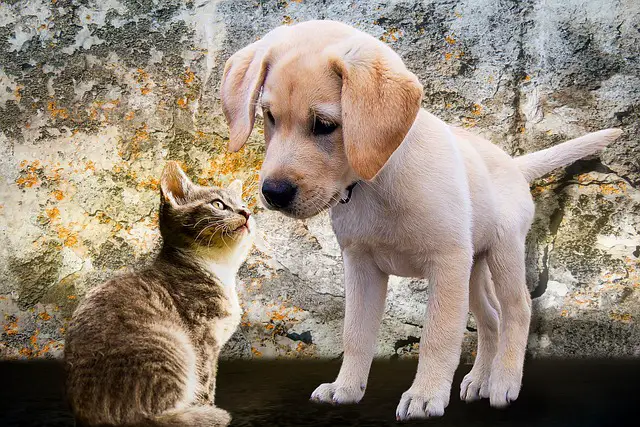Understanding the intricate nuances of canine and feline behavior is essential for fostering a harmonious environment in households with both dogs and cats. Dogs, often hailed as man’s best friend, bring a unique set of characteristics to the table. Their loyalty, sociability, and boundless energy make them cherished companions for those seeking dynamic interactions.
Cats, on the other hand, possess a distinctive elegance and independence that sets them apart. While they can form deep bonds with their human counterparts, they also value solitude and personal space. Recognizing and appreciating these fundamental differences is the foundation for a successful multi-pet household.
communication between dogs and cats becomes crucial
In a multi-species environment, effective communication between dogs and cats becomes crucial. Dogs, being pack animals, often express themselves through body language, vocalizations, and various gestures. Understanding the subtle cues can prevent misunderstandings and conflicts. For instance, a wagging tail in a dog may signify excitement, while in a cat, it might indicate agitation.
Cats, known for their subtlety, communicate through vocalizations, body postures, and tail movements. A softly purring cat may be content, while a flicking tail might indicate annoyance or agitation. Recognizing and respecting these signals enhances the overall cohabitation experience.
Training plays a pivotal role in creating a cohesive environment. Positive reinforcement techniques can be applied to both dogs and cats, emphasizing desired behaviors and discouraging undesirable ones. Consistency in training methods across species promotes a shared understanding of household rules.
The introduction phase is a critical aspect of bringing a new dog into a cat-inhabited space or vice versa. Gradual, supervised introductions allow pets to acclimate to each other’s scents and presence. Providing safe spaces for retreat and maintaining a calm atmosphere during these initial encounters contributes to a smoother integration process.
Feeding schedules necessitate careful planning to accommodate the nutritional needs of both dogs and cats. Separate feeding areas help prevent food-related conflicts, ensuring that each pet gets the appropriate diet without competition. It’s imperative to select pet food tailored to the specific dietary requirements of each species.
Managing the territorial instincts of both dogs and cats requires strategic planning. Creating designated spaces for each pet, equipped with comfortable beds and toys, allows them to have their territories while minimizing potential disputes. Vertical spaces, such as cat trees or shelves, provide felines with elevated vantage points, satisfying their natural instinct to observe from above.
The grooming routine is another aspect that demands attention. While dogs may require regular baths and nail trims, cats are meticulous groomers and may need less hands-on grooming. Providing appropriate grooming tools for each species, such as brushes and nail clippers, contributes to their overall well-being.
Understanding the health considerations for multi-pet households involves regular veterinary check-ups, parasite prevention, and vaccinations tailored to the needs of both dogs and cats. Maintaining a clean living environment, including litter box hygiene and waste disposal, is crucial for preventing the spread of illnesses.
navigating the intricate dynamics between dogs and cats in a multi-pet household requires a deep understanding of their individual behaviors, needs, and communication styles. By recognizing and respecting their differences, implementing effective training, and creating an environment that caters to their distinct requirements, pet owners can foster a harmonious and enriching cohabitation experience.
Understanding Canine and Feline Behavior: A Comprehensive Guide for Pet Owners
Unlocking the secrets of canine and feline behavior is the key to a harmonious multi-pet household. Learn how to decipher the unique language of dogs and cats, ensuring a bond that goes beyond cohabitation. From tail wags to purrs, this comprehensive guide empowers pet owners to navigate the intricacies of their furry companions’ behaviors. Enhance your understanding, strengthen your connection, and create a living space where dogs and cats thrive together. Discover the art of fostering a true pet haven with our in-depth guide to canine and feline behavior.
How to Introduce a New Dog to a Household with Existing Cats
Introducing a new dog to a household with existing cats requires a thoughtful and gradual approach to ensure a smooth transition for all furry members. The initial phase of this process involves allowing pets to become acquainted with each other’s scents before direct face-to-face meetings. This can be achieved by exchanging bedding or toys between the dog and cats, familiarizing them with the presence of a new companion.
Controlled meetings play a pivotal role in shaping the dynamics between the dog and cats. During these encounters, it’s essential to keep the dog on a leash to ensure the safety of all pets involved. Allowing the cats to approach the dog at their own pace while offering treats and praise for calm behavior establishes positive associations.
Creating safe spaces for the cats is crucial during the introduction phase. Cats should have access to elevated areas or hiding spots where they can observe the new dog without feeling threatened. This not only reduces stress for the cats but also promotes a sense of security.
Positive reinforcement is a powerful tool throughout the introduction process. Rewarding calm behavior from both the dog and cats with treats and affection reinforces positive interactions. This approach helps create a positive association between the new dog and the existing feline residents.
Maintaining patience and allowing for a gradual adjustment period is essential. It’s normal for cats to be cautious or apprehensive initially, and the process should proceed at their pace. Monitoring the body language of all pets involved is crucial, as signs of stress or discomfort should be addressed promptly.
As the pets become more accustomed to each other, supervised interactions can be expanded to include play sessions. Engaging in interactive play with toys that appeal to both dogs and cats helps build positive associations and strengthens the bond between them.
The integration process is not limited to the initial introduction phase. Ongoing management of the living space, feeding schedules, and individual attention for each pet is vital for long-term harmony. Creating an environment where each pet feels secure and valued contributes to a successful multi-species household.
In conclusion, introducing a new dog to a household with existing cats requires patience, strategic planning, and a deep understanding of the individual needs of each pet. By following a gradual and positive introduction process, pet owners can pave the way for a harmonious cohabitation experience that benefits both the new canine addition and the resident feline companions.
Best Breeds for Families with Both Dogs and Cats
Choosing the right breeds is a critical aspect of creating a harmonious multi-pet household. Certain dog breeds are known for their compatibility with cats, making them ideal choices for families seeking a diverse yet cohesive pet dynamic.
- Golden Retriever: Renowned for their gentle and friendly nature, Golden Retrievers often get along well with cats. Their sociable disposition and adaptability make them excellent companions for families with both dogs and cats.
- Beagle: Beagles are generally sociable and tolerant, traits that contribute to their positive interactions with cats. Their moderate size and friendly demeanor make them suitable for households with multiple pets.
- Basset Hound: With a laid-back demeanor, Basset Hounds often coexist peacefully with both dogs and cats. Their calm nature and manageable size make them well-suited for families seeking a harmonious pet environment.
- Collie: Collies are known for their intelligence and gentle disposition. Their herding instincts can translate into a watchful yet gentle presence, making them suitable for households with both dogs and cats.
- Birman Cat: Among cat breeds, Birmans stand out for their social and adaptable nature. Their friendly demeanor makes them well-suited for families with both dogs and cats, fostering a sense of camaraderie among the furry residents.
Selecting breeds with compatible temperaments is crucial for minimizing potential conflicts and creating a positive environment for all pets involved. The following breeds exemplify characteristics that contribute to successful multi-species households.
Specific Health Considerations for Multi-Pet Households with Dogs and Cats
Maintaining the health and well-being of both dogs and cats in a multi-pet household involves proactive care, regular veterinary visits, and a keen understanding of their unique health considerations.
- Parasite Control: Fleas, ticks, and other parasites can pose a threat to both dogs and cats. Implementing a comprehensive parasite control plan, including regular vet-recommended treatments, helps safeguard the health of all pets in the household.
- Dietary Needs: Dogs and cats have distinct dietary requirements. While dogs are omnivores with specific nutritional needs, cats are obligate carnivores. Providing balanced and species-appropriate diets tailored to their individual needs is essential for their overall health.
- Stress Management: The dynamics of living with both dogs and cats can sometimes induce stress in one or more pets. Recognizing signs of stress, such as changes in behavior, appetite, or grooming habits, allows for prompt intervention. Creating a calm environment, offering safe spaces, and providing individual attention contribute to stress management.
- Hygiene Practices: Maintaining a clean living environment is crucial for preventing the spread of illnesses. Regular grooming, litter box maintenance, and proper waste disposal help create a hygienic space for both dogs and cats.
- Regular Vet Check-ups: Scheduled veterinary visits are fundamental for monitoring the overall health of dogs and cats. Routine check-ups allow veterinarians to detect and address potential health issues early, ensuring optimal well-being.
Understanding the specific health considerations for multi-pet households empowers pet owners to provide proactive care and create an environment where both dogs and cats can thrive.
Managing the Feeding Schedule for Dogs and Cats Living Together
Establishing a well-managed feeding schedule is a key component of ensuring the health and harmony of both dogs and cats living together. Consider the following strategies for managing the feeding schedule in a multi-pet household:
- Separate Feeding Areas: Designate distinct feeding areas for dogs and cats to prevent competition or food-related conflicts. Cats, in particular, may prefer elevated spaces for their meals.
- Scheduled Meal Times: Establish consistent meal times for both dogs and cats. Regular feeding schedules help regulate their digestive systems and contribute to a predictable routine.
- Individualized Diets: Tailor the diet to the specific nutritional needs of each species. Dogs and cats have different dietary requirements, so choose appropriate food formulations for optimal health.
- Supervised Meals: If necessary, supervise meals to ensure that each pet consumes its own food without interference from others. This prevents overeating or potential food-related disputes.
- Monitoring Eating Habits: Keep a close eye on the eating habits of both dogs and cats. Changes in appetite or eating behavior can be indicators of health issues, and prompt attention is crucial for addressing potential concerns.
By implementing a well-thought-out feeding schedule, pet owners can maintain order and prevent conflicts during meal times. Consistency in feeding routines contributes to a positive environment where both dogs and cats can enjoy their meals without stress or competition.
Effective Training Techniques for Ensuring Harmony Between Dogs and Cats
Successful cohabitation between dogs and cats hinges on effective training techniques that promote understanding, cooperation, and harmony. Consider the following strategies for training both dogs and cats in a multi-pet household:
- Positive Reinforcement: Utilize positive reinforcement to encourage desirable behaviors in both dogs and cats. Rewarding good behavior with treats, praise, or affection reinforces positive associations and motivates pets to repeat those behaviors.
- Consistent Commands: Establish consistent commands for both dogs and cats. Using the same cues and commands
FAQ’s :
- Q: How does the social behavior of dogs differ from that of cats?
- A: Dogs are pack animals and thrive on social interaction, while cats are more independent and territorial.
- Q: Why do dogs seem more eager for human interaction compared to cats?
- A: Dogs have been bred for companionship and often form strong bonds with humans, seeking attention and affection.
- Q: Are cats less trainable than dogs due to their independent nature?
- A: Cats can be trained, but they respond better to positive reinforcement and may not be as eager to please as dogs.
- Q: What role does territorial behavior play in the differences between dogs and cats?
- A: Cats are highly territorial and may mark their territory with scent glands, while dogs may mark through urine.
- Q: How do the hunting instincts of cats compare to the protective instincts of dogs?
- A: Cats have a strong hunting instinct, while dogs often exhibit protective behaviors, making them effective guard animals.
- Q: Why do dogs exhibit pack behaviors, and how does it influence their behavior at home?
- A: Dogs have a pack mentality inherited from their wolf ancestors, impacting their social structure and interactions within a household.
- Q: Do cats form strong bonds with their owners despite their independent demeanor?
- A: Yes, cats can form strong attachments to their owners, but their expressions of affection may be more subtle compared to dogs.
- Q: How does play behavior differ between dogs and cats, and why is it important for both?
- A: Dogs engage in more physical play, reflecting their pack instincts, while cats often exhibit stalking and pouncing behaviors as a form of play.
- Q: What role does body language play in understanding the emotional state of dogs and cats?
- A: Both dogs and cats communicate through body language, but the signals may differ. Understanding these cues is crucial for effective interaction.
- Q: Can the differences in behavior between dogs and cats be attributed to their evolutionary history?
- A: Yes, the domestication process and selective breeding have influenced the behavior of both species, shaping their unique traits and characteristics.

Hi, I’m Jodie! I’m a spain-Moroccan writer with a passion for imagination, adventures, magic and stories with heart.
Please don’t hesitate to contact me for any questions, suggestions, comments or feedback.

















Add comment